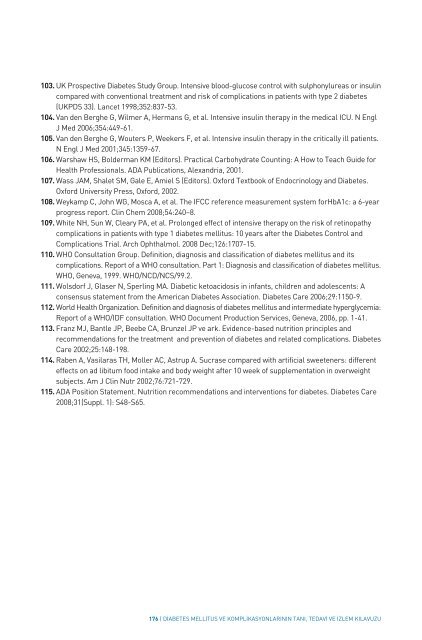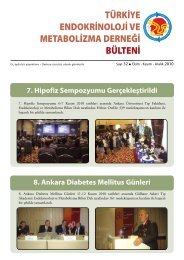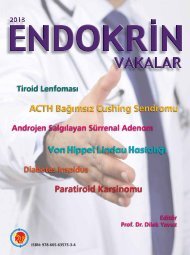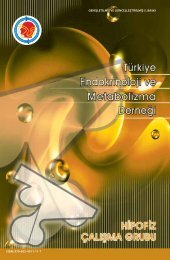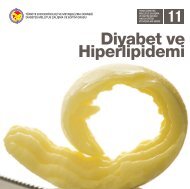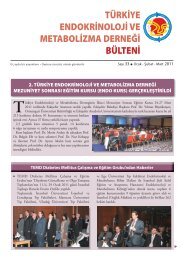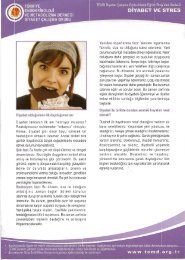Diabetes mellitus ve komplikasyonlarının tanı,tedavi ve izlem ...
Diabetes mellitus ve komplikasyonlarının tanı,tedavi ve izlem ...
Diabetes mellitus ve komplikasyonlarının tanı,tedavi ve izlem ...
You also want an ePaper? Increase the reach of your titles
YUMPU automatically turns print PDFs into web optimized ePapers that Google loves.
103. UK Prospecti<strong>ve</strong> <strong>Diabetes</strong> Study Group. Intensi<strong>ve</strong> blood-glucose control with sulphonylureas or insulin<br />
compared with con<strong>ve</strong>ntional treatment and risk of complications in patients with type 2 diabetes<br />
(UKPDS 33). Lancet 1998;352:837-53.<br />
104. Van den Berghe G, Wilmer A, Hermans G, et al. Intensi<strong>ve</strong> insulin therapy in the medical ICU. N Engl<br />
J Med 2006;354:449-61.<br />
105. Van den Berghe G, Wouters P, Weekers F, et al. Intensi<strong>ve</strong> insulin therapy in the critically ill patients.<br />
N Engl J Med 2001;345:1359-67.<br />
106. Warshaw HS, Bolderman KM (Editors). Practical Carbohydrate Counting: A How to Teach Guide for<br />
Health Professionals. ADA Publications, Alexandria, 2001.<br />
107. Wass JAM, Shalet SM, Gale E, Amiel S (Editors). Oxford Textbook of Endocrinology and <strong>Diabetes</strong>.<br />
Oxford Uni<strong>ve</strong>rsity Press, Oxford, 2002.<br />
108. Weykamp C, John WG, Mosca A, et al. The IFCC reference measurement system forHbA1c: a 6-year<br />
progress report. Clin Chem 2008;54:240–8.<br />
109. White NH, Sun W, Cleary PA, et al. Prolonged effect of intensi<strong>ve</strong> therapy on the risk of retinopathy<br />
complications in patients with type 1 diabetes <strong>mellitus</strong>: 10 years after the <strong>Diabetes</strong> Control and<br />
Complications Trial. Arch Ophthalmol. 2008 Dec;126:1707-15.<br />
110. WHO Consultation Group. Definition, diagnosis and classification of diabetes <strong>mellitus</strong> and its<br />
complications. Report of a WHO consultation. Part 1: Diagnosis and classification of diabetes <strong>mellitus</strong>.<br />
WHO, Geneva, 1999. WHO/NCD/NCS/99.2.<br />
111. Wolsdorf J, Glaser N, Sperling MA. Diabetic ketoacidosis in infants, children and adolescents: A<br />
consensus statement from the American <strong>Diabetes</strong> Association. <strong>Diabetes</strong> Care 2006;29:1150-9.<br />
112. World Health Organization. Definition and diagnosis of diabetes <strong>mellitus</strong> and intermediate hyperglycemia:<br />
Report of a WHO/IDF consultation. WHO Document Production Services, Geneva, 2006, pp. 1-41.<br />
113. Franz MJ, Bantle JP, Beebe CA, Brunzel JP <strong>ve</strong> ark. Evidence-based nutrition principles and<br />
recommendations for the treatment and pre<strong>ve</strong>ntion of diabetes and related complications. <strong>Diabetes</strong><br />
Care 2002;25:148-198.<br />
114. Raben A, Vasilaras TH, Moller AC, Astrup A. Sucrase compared with artificial sweeteners: different<br />
effects on ad libitum food intake and body weight after 10 week of supplementation in o<strong>ve</strong>rweight<br />
subjects. Am J Clin Nutr 2002;76:721-729.<br />
115. ADA Position Statement. Nutrition recommendations and inter<strong>ve</strong>ntions for diabetes. <strong>Diabetes</strong> Care<br />
2008;31(Suppl. 1): S48-S65.<br />
176 | DİABETES MELLİTUS VE KOMPLİKASYONLARININ TANI, TEDAVİ VE İZLEM KILAVUZU


